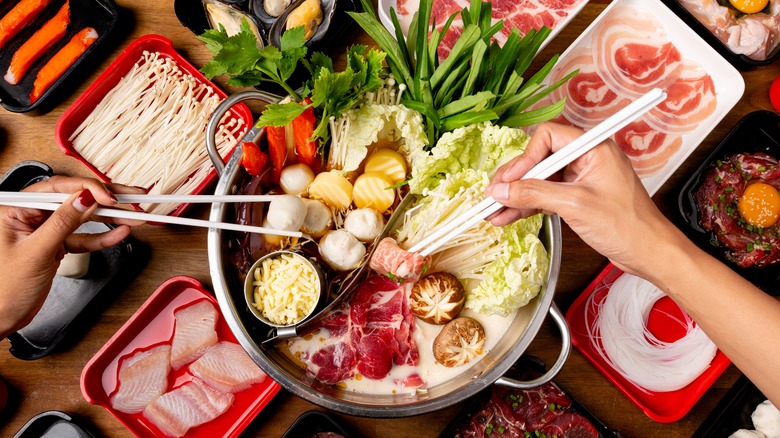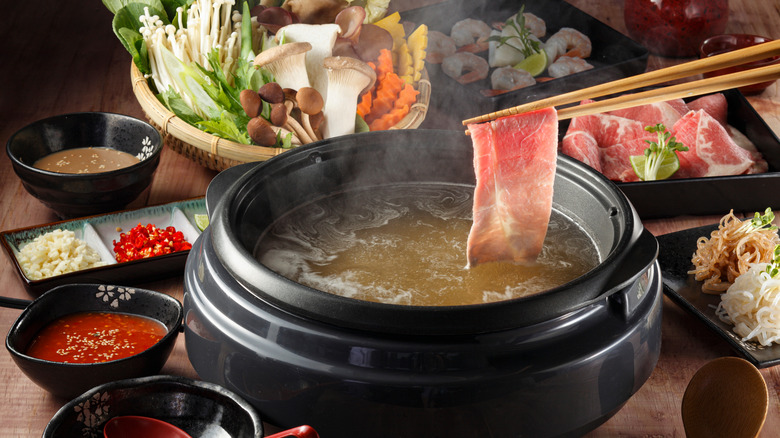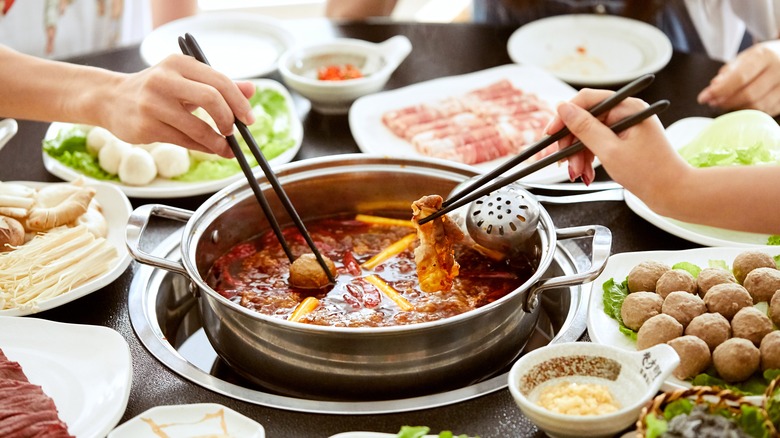Mind The Seasoning If You're Making Homemade Hot Pot Broth
Chinese hot pot is a great reason to gather friends and family around the same table to enjoy the steaming, fragrant broth and good conversation. The act of cooking the thinly sliced meat and tender vegetables in the broth gives everyone an excuse to slow down, eat well, and enjoy the pace of the meal, instead of rushing through the meal.
For hot pot, the broth is the centerpiece, yet it also needs to fulfill a supporting role as the base for the whole meal. A mild hot pot broth usually has some aromatics, herbs, perhaps some vegetables, and has a base of meat like pork, beef, or chicken, or vegetables. There are different kinds of broths, like tomato, or spicy broths like Chongqing, Sichuan, or Mongolian. No matter what kind of broth you're serving at your next hot pot night, it should be delicately flavored to not overshadow the fresh ingredients.
Hot pot broth should be mild
The broth for your hot pot shouldn't be too strongly flavored, because you want to taste what you've cooked, like a paper-thin slice of pork belly or a broth-soaked tofu puff. As you cook the meat and vegetables in the broth, the flavor will change, and hopefully by the end you won't be able to resist slurping a bowl of the flavorful broth with some noodles and greens.
You'll want basically a blank slate, nothing too strongly flavored but not bland. You can use a simple broth of water, scallions, and ginger, or make a clear broth with scrubbed pork bones. Use chicken powder or a small bit of bouillon to flavor your broth, with a dash of white pepper and salt to season — your average store-bought chicken broth won't cut it here. Your starting broth should also be clear and taste light. Even Sichuan hot pot is delicately flavored — not overly salty, just oil, spice, and the clear broth.
Hot pot is an easy meal to host at home
Doing hot pot at home may seem like a chore but with a few preparation steps it's a rather easy meal to set up. And as the host, you don't really have to do any cooking, because the guests will do it themselves — it's the perfect low-effort meal. Choose a broth flavor or two, and then slice as many veggies as you want like Napa cabbage, bok choy, spinach, tatsoi, enoki mushrooms — even potatoes are an excellent hot pot addition. If you're hosting meat eaters, your local Asian shops should be stocked with frozen rolls of thinly sliced beef and pork, as well as meatballs and fish balls. If you don't have an Asian market nearby, putting the meat in the freezer to firm it up before slicing should be enough to get thin slices of meat. Don't be afraid to experiment with other additions like tofu in all its shapes and sizes, like puffs, firm tofu, or tofu sheets. Noodles wouldn't be out of place, either.
Hot pot is usually accompanied by a dipping sauce for your cooked foods. The base is usually Chinese sesame paste, peanut butter, or soy sauce, to which you can add all manner of aromatics and spices, like garlic, scallions, cilantro, chili oil, or black vinegar. Just set out the ingredients and let your guests mix their own sauces.


